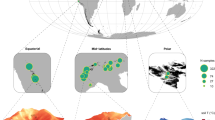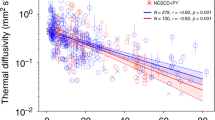Abstract
Soil macroporosity affects field-scale water-cycle processes, such as infiltration, nutrient transport and runoff1,2, that are important for the development of successful global strategies that address challenges of food security, water scarcity, human health and loss of biodiversity3. Macropores—large pores that freely drain water under the influence of gravity—often represent less than 1 per cent of the soil volume, but can contribute more than 70 per cent of the total soil water infiltration4, which greatly magnifies their influence on the regional and global water cycle. Although climate influences the development of macropores through soil-forming processes, the extent and rate of such development and its effect on the water cycle are currently unknown. Here we show that drier climates induce the formation of greater soil macroporosity than do more humid ones, and that such climate-induced changes occur over shorter timescales than have previously been considered—probably years to decades. Furthermore, we find that changes in the effective porosity, a proxy for macroporosity, predicted from mean annual precipitation at the end of the century would result in changes in saturated soil hydraulic conductivity ranging from −55 to 34 per cent for five physiographic regions in the USA. Our results indicate that soil macroporosity may be altered rapidly in response to climate change and that associated continental-scale changes in soil hydraulic properties may set up unexplored feedbacks between climate and the land surface and thus intensify the water cycle.
This is a preview of subscription content, access via your institution
Access options
Access Nature and 54 other Nature Portfolio journals
Get Nature+, our best-value online-access subscription
$29.99 / 30 days
cancel any time
Subscribe to this journal
Receive 51 print issues and online access
$199.00 per year
only $3.90 per issue
Buy this article
- Purchase on Springer Link
- Instant access to full article PDF
Prices may be subject to local taxes which are calculated during checkout



Similar content being viewed by others
Data availability
The soil and climatological datasets generated and analysed during this study are publicly available in the GitHub repository, https://github.com/danielhirmas/nature2017-07-09186B. The soil datasets used in this study are also publicly available through the USDA-NRCS NCSS data repository, http://ncsslabdatamart.sc.egov.usda.gov/.
References
Beven, K. & Germann, P. Macropores and water flow in soils revisited. Wat. Resour. Res. 49, 3071–3092 (2013).
Jarvis, N. J. A review of non-equilibrium water flow and solute transport in soil macropores: principles, controlling factors and consequences for water quality. Eur. J. Soil Sci. 58, 523–546 (2007).
Janzen, H. H. et al. Global prospects rooted in soil science. Soil Sci. Soc. Am. J. 75, 1–8 (2011).
Watson, K. W. & Luxmoore, R. J. Estimating macroporosity in a forest watershed by use of a tension infiltrometer. Soil Sci. Soc. Am. J. 50, 578–582 (1986).
Lawrence, D. M. et al. Parameterization improvements and functional and structural advances in version 4 of the Community Land Model. J. Adv. Model. Earth Syst. 3, M03001 (2011).
Clark, M. P. et al. Improving the representation of hydrologic processes in Earth System Models. Wat. Resour. Res. 51, 5929–5956 (2015).
Hassink, J. The capacity of soils to preserve organic C and N by their association with clay and silt particles. Plant Soil 191, 77–87 (1997).
Bronick, C. J. & Lal, R. Soil structure and management: a review. Geoderma 124, 3–22 (2005).
Taina, I. A., Heck, R. J., Deen, W. & Ma, E. Y. T. Quantification of freeze–thaw related structure in cultivated topsoils using X-ray computer tomography. Can. J. Soil Sci. 93, 533–553 (2013).
Brimhall, G. H. et al. Deformational mass transport and invasive processes in soil evolution. Science 255, 695–702 (1992).
Platt, B. F., Kolb, D. J., Kunhardt, C. G., Milo, S. P. & New, L. G. Burrowing through the literature: the impact of soil-disturbing vertebrates on physical and chemical properties of soil. Soil Sci. 181, 175–191 (2016).
Robinson, D. A. et al. Experimental evidence for drought induced alternative stable states of soil moisture. Sci. Rep. 6, 20018 (2016).
Rawls, W. J., Giménez, D. & Grossman, R. Use of soil texture, bulk density, and slope of the water retention curve to predict saturated hydraulic conductivity. Trans. ASAE 41, 983–988 (1998).
Nemes, A., Rawls, W. J. & Pachepsky, Y. A. Influence of organic matter on the estimation of saturated hydraulic conductivity. Soil Sci. Soc. Am. J. 69, 1330–1337 (2005).
Tilman, D. Global environmental impacts of agricultural expansion: the need for sustainable and efficient practices. Proc. Natl Acad. Sci. USA 96, 5995–6000 (1999).
Foley, J. A. et al. Global consequences of land use. Science 309, 570–574 (2005).
West, L. T., Shaw, J. N. & Mersiovsky, E. P. in The Soils of the USA (eds West, L. T. et al.) Ch. 13 (Springer, Cham, 2017).
Peel, M. C., Finlayson, B. L. & McMahon, T. A. Updated world map of the Köppen–Geiger climate classification. Hydrol. Earth Syst. Sci. 11, 1633–1644 (2007).
Taylor, K. E., Stouffer, R. J. & Meehl, G. A. An overview of CMIP5 and the experimental design. Bull. Am. Meteorol. Soc. 93, 485–498 (2012).
Huntington, T. G. Evidence for intensification of the global water cycle: review and synthesis. J. Hydrol. 319, 83–95 (2006).
Jung, M. et al. Recent decline in the global land evapotranspiration trend due to limited moisture supply. Nature 467, 951–954 (2010).
Anselin, L. Exploring Spatial Data with GeoDa TM : A Workbook (Center for Spatially Integrated Social Science, 2005).
Anselin, L. & Bera, A. in Handbook of Applied Economic Statistics (eds Ullah, A. & Giles, D. E. A.) Ch. 7 (Marcel Dekker, New York, 1998).
Williams, C. N. Jr, Vose, R. S., Easterling, D. R. & Menne, M. J. United States Historical Climatology Network Daily Temperature, Precipitation, and Snow Data. (Oak Ridge National Laboratory, 2006).
Petrie, M. D. & Brunsell, N. A. The role of precipitation variability on the ecohydrology of grasslands. Ecohydrology 5, 337–345 (2012).
Daly, C. et al. Physiographically sensitive mapping of climatological temperature and precipitation across the conterminous United States. Int. J. Climatol. 28, 2031–2064 (2008).
Venables, W. N. & Ripley, B. D. Modern Applied Statistics with S 4th edn (Springer, New York, 2002).
Korkmaz, S., Goksuluk, D. & Zararsiz, G. MVN: An R package for assessing multivariate normality. R J. 6, 151–162 (2014).
R Core Team. R: A Language and Environment for Statistical Computing version 3.0.2 (R Foundation for Statistical Computing, 2013).
Acknowledgements
D.R.H. and D.G. thank R. Miskewitz for assistance in assigning Köppen–Geiger classes to the samples in the dataset. A.N., D.G. and D.R.H. thank the Norwegian Institute of Bioeconomy Research (NIBIO) for financial support. N.A.B. acknowledges funding support through USDA-AFRI 2014-67003-22070.
Reviewer information
Nature thanks P. Hallett, D. Robinson and the other anonymous reviewer(s) for their contribution to the peer review of this work.
Author information
Authors and Affiliations
Contributions
D.R.H., D.G., A.N. and N.A.B. designed the study examining effective porosity with climate. A.N. and D.R.H. compiled the USDA-NRCS NCSS data. N.A.B. and C.J.W. compiled and analysed the atmospheric data. D.R.H. wrote the first draft of the paper and, with R.K., conducted the statistical analyses. All authors edited and commented on the manuscript and contributed to later iterations.
Corresponding author
Ethics declarations
Competing interests
The authors declare no competing interests.
Additional information
Publisher’s note: Springer Nature remains neutral with regard to jurisdictional claims in published maps and institutional affiliations.
Extended data figures and tables
Extended Data Fig. 1 Distribution of selected soil samples and USHCN weather stations used in this study.
a–d, Locations of A horizons (a), B horizons (b), Ap horizons (c) and USHCN weather stations (d). Weather stations that recorded continuous data since at least 1951 were selected. Soil sample data were obtained from the NCSS Characterization Database on 10 July 2013. Depth and soil morphological criteria for selection of the A, Ap and B horizon samples are given in Extended Data Table 1.
Extended Data Fig. 2 Interpolated maps of mean precipitation magnitude per event and mean precipitation event timing from USHCN weather station data.
a, Interpolated map of the mean precipitation magnitude per event (PM; in millimetres), calculated assuming that the magnitude of precipitation events followed an exponential distribution. b, Interpolated map of the mean precipitation event timing (PT; in events per day), calculated from a Poisson distribution for days with a precipitation event. Weather stations that recorded continuous data since at least 1951 were selected.
Rights and permissions
About this article
Cite this article
Hirmas, D.R., Giménez, D., Nemes, A. et al. Climate-induced changes in continental-scale soil macroporosity may intensify water cycle. Nature 561, 100–103 (2018). https://doi.org/10.1038/s41586-018-0463-x
Received:
Accepted:
Published:
Issue Date:
DOI: https://doi.org/10.1038/s41586-018-0463-x
Keywords
This article is cited by
-
River water quality shaped by land–river connectivity in a changing climate
Nature Climate Change (2024)
-
Spatial distribution of theoretical soil macropores on a continental scale and its eco-hydrological significance in China
Journal of Soils and Sediments (2024)
-
The trilemma of the water-pricing policy, the social function of water, and the threats to water security in a Metropolitan Region
Sustainable Water Resources Management (2023)
-
Analytical modelling of soil porosity and bulk density across the soil organic matter and land-use continuum
Scientific Reports (2022)
-
Soil hydrology in the Earth system
Nature Reviews Earth & Environment (2022)
Comments
By submitting a comment you agree to abide by our Terms and Community Guidelines. If you find something abusive or that does not comply with our terms or guidelines please flag it as inappropriate.



